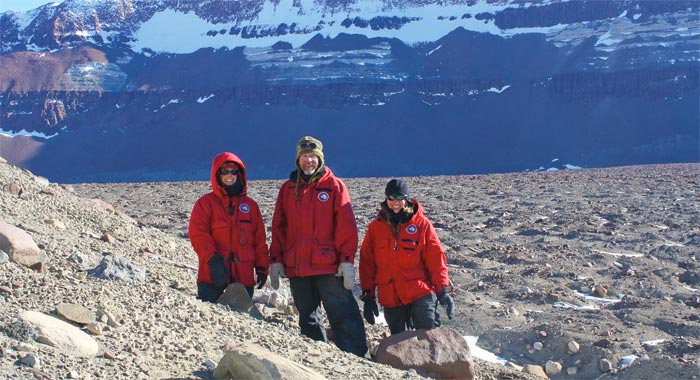Ice Cubed
Three generations of St. Norbert geology spent the month of January 2011 working together in the (cold) fields of Antarctica.
As continents go, it doesn’t get any higher, drier or windier than Antarctica. Ice covers 98 percent of it to a depth averaging more than a mile, and yet it’s technically a desert, getting less than 2 inches of precipitation per year. Such a place brings people together simply as a matter of survival. But the weeks Tim Flood (Geology) and Nicole Bader ’11 spent on the continent during winter break involved teamwork much deeper than that. Flood and Bader, his student, traveled to the planet’s most remote location to assist with the climate-change research of Kathy Licht ’92, a former student of Flood’s who is now associate professor of earth sciences at Indiana University-Purdue University Indianapolis.
Still an undergraduate, Bader (above) was able to complete all the fieldwork for her master’s degree next year at IUPUI. As principal investigator on a National Science Foundation grant, Licht is mapping the movement of two glaciers during the past 500,000 years. Bader will analyze the field samples collected as she begins pursuit of her master’s degree under Licht this fall.
Naming high points of the experience, Bader says: “My current professor was my field assistant! He helped me to put the till and pebbles into bags, label the bags, and even carry them around the moraine. I have all of my fieldwork done for next year at IUPUI – and I’m still an undergrad.”
Licht, whose own first field experiences included research in Costa Rica and Belize with Flood, says, “Without Tim’s guidance, I would never be where I am today, so I am very pleased to try to continue his legacy and pay it forward by providing new and hopefully exciting educational opportunities to students.”
Along with ice samples, the team collected striking memories of the trip. The excerpts on these pages are taken from their blog.
***
Outfitting for Antarctica is an adventure. At the Clothing Distribution Center in Christchurch, New Zealand, everyone is issued a Big Red parka rated for 50 degrees below zero, white ultra-cold-weather “bunny boots” and cold-weather bibs, mittens, socks and a face mask. During the five-hour flight to Antarctica via C17 cargo plane, the bunny boots, parka and bibs must be worn. Putting on all the clothes in one’s closet might provide an idea of what wearing the cold-weather gear feels like.
***
McMurdo Station, the American base of operations in Antarctica, is located about 40 miles offshore on Ross Island. It takes an hour’s ride on a bus known as “Ivan the Terrible” to reach McMurdo from the Pegasus airstrip, 15 miles away on the Ross Ice Shelf. During the summer – December to February – the temperatures around McMurdo are mostly above zero. What does get you is the Katabatic winds, which flow off the higher Antarctic Plateau like water over a waterfall. Wind speeds of 40 mph are common. Safety is a top priority. Any group away from McMurdo must check in to “ops” every morning and every evening. Five minutes late for check-in, and Search and Rescue (SAR) is notified; 20 minutes late, and SAR is mobilized.
***
We left McMurdo for a base camp called CTAM (Central TransAntarctic Mountains) about 400 miles from the South Pole. Then the five of us – four geologists and a mountaineer – headed to our remote camp, located on an ice flow about a six-hour snowmobile ride from CTAM. The ice there was about a third of a mile thick, and the nearest rock, a mountain peak sticking up through the ice, was more than a mile away. Our camp consisted of five mountain tents, two tepee-like Scott tents and one cooking tent that looked like a Conestoga wagon without wheels. Cooking on two Coleman stoves was by rotation, not invitation, yet all meals were surprisingly good. Hunger and cold do wonders for the taste of food. The biggest camp chore was getting water. An area near the cook tent was flagged off for procuring snow, which was shoveled into a large garbage bag and hauled into the tent to keep the water pots stocked. The never-ending process allowed for no spare water, which meant personal hygiene was performed infrequently, by baby-wipe.
***
From our remote camp, we traveled one to two hours by snowmobile to our field site each day. On three occasions, a helicopter from CTAM took us to less accessible field areas. Typically, we would spend 12 hours in the field, come “home” and cook, then head off to our tents to sleep. As a team, we are trying to figure out the movement of two glaciers. This determination will serve as a proxy for global climate change over that same time interval. This work required detailed field sampling and will require labor-intensive laboratory analysis. We anticipate several publications in national and international journals over the next few years. If the science is good, we will hopefully raise more questions than we answer.












